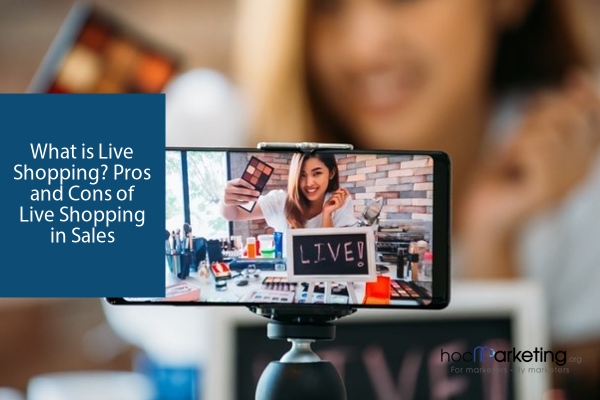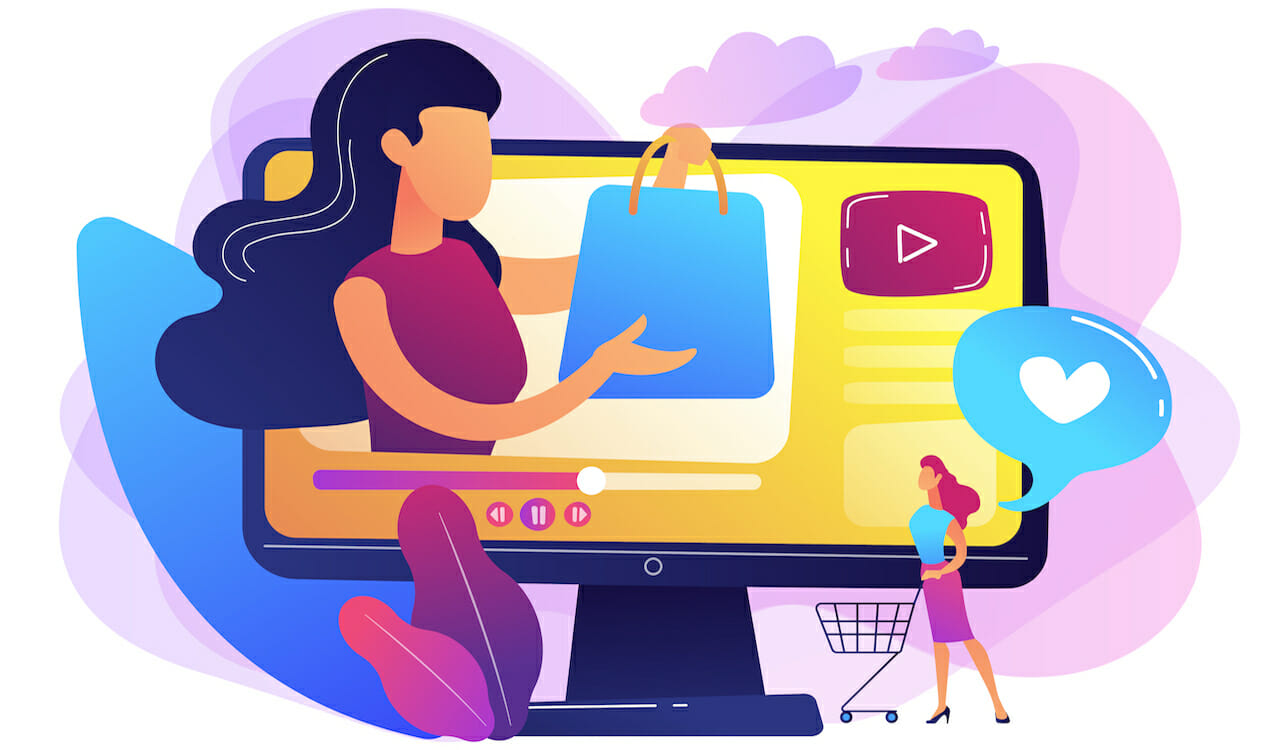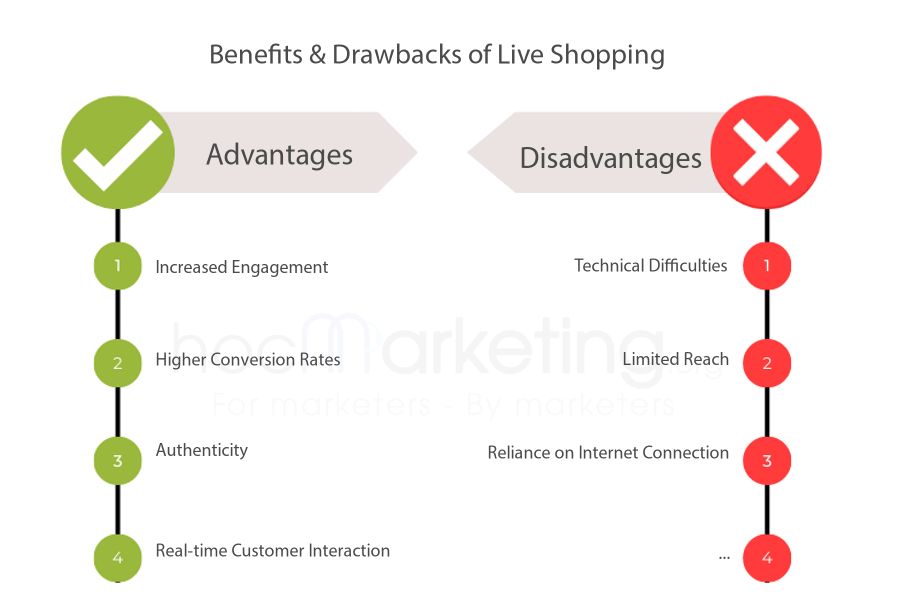
What is Live Shopping? Pros and Cons of Live Shopping in Sales

Discover the pros and cons of live shopping in sales with this informative article. Explore the benefits of increased engagement, higher conversion rates, authenticity, and real-time customer interaction. Learn about potential drawbacks such as technical difficulties, limited reach, and reliance on internet connection.
Live shopping is a relatively new concept in the world of e-commerce that has been gaining popularity in recent years. It is a form of online retail where businesses use live video streaming to showcase their products and services to potential customers in real-time. During the live stream, viewers are able to interact with the host and ask questions about the products being showcased. In this blog post, we will explore the pros and cons of live shopping, as well as some examples of successful live shopping campaigns. Whether you are a business owner looking to try out this new trend or a curious shopper interested in learning more, keep reading to discover what live shopping is all about.
What is Live Shopping?
Live shopping is a relatively new trend in the world of e-commerce that has gained popularity over the past few years. Simply put, live shopping involves broadcasting a live video stream in which a presenter showcases and sells products in real-time. This form of marketing offers a more interactive and engaging shopping experience for consumers, allowing them to ask questions, see products in action, and receive instant feedback. Live shopping can take place on various social media platforms such as Facebook, Instagram, and YouTube, and can also be hosted on dedicated e-commerce platforms. In the following sections, we will explore the benefits and drawbacks of live shopping, as well as examples of successful live shopping campaigns.
Benefits of Live Shopping
Live Shopping has become an increasingly popular trend in the e-commerce industry. This is a type of online shopping experience where customers can watch a live stream of a business or influencer showcasing their products, and purchase items in real-time. While this may seem like a new concept, it has quickly gained a lot of attention due to its numerous benefits.
One of the main benefits of Live Shopping is increased engagement. By providing a live stream, businesses can connect with their customers in a more personal and interactive way. This helps to build trust and loyalty, and ultimately drives sales. Additionally, Live Shopping allows customers to ask questions and get immediate feedback, which can help to address any concerns or doubts they may have about a product.
Another benefit of Live Shopping is higher conversion rates. This is because customers are able to see the product in action, and get a better sense of its features and benefits. Additionally, the sense of urgency created by the live stream can encourage customers to make a purchase sooner rather than later. This can lead to a higher ROI for businesses, and a better overall shopping experience for customers.
Authenticity is also a key benefit of Live Shopping. By showcasing products in real-time, businesses can demonstrate their authenticity and transparency. This helps to build trust with customers, and can ultimately lead to repeat business. Additionally, Live Shopping can help to humanize a brand, making it more relatable and approachable.
Finally, Live Shopping offers real-time customer interaction. This means that businesses can get immediate feedback on their products, and make adjustments as needed. Additionally, this can help to build relationships with customers, and foster a sense of community around a brand. Overall, Live Shopping can be a valuable tool for businesses looking to increase engagement, drive sales, and build lasting relationships with their customers.
Increased Engagement
Live shopping is a trend that has been gaining popularity in recent years. It involves broadcasting a live video of a product or service being demonstrated and sold in real-time. Live shopping has numerous benefits, one of which is increased engagement.
Live shopping allows customers to interact with the seller in real-time, making the experience more engaging. Customers can ask questions about the product or service being sold, get immediate answers, and even request demonstrations. This level of interaction helps to build trust between the seller and the customer, making it more likely that the customer will make a purchase.
Furthermore, live shopping can create a sense of urgency among customers. Since the broadcast is live and may have a limited duration, customers may feel compelled to make a purchase before the broadcast ends. This sense of urgency can help to increase sales and revenue.
Overall, live shopping provides a unique and engaging experience for customers, which can lead to increased sales and revenue for businesses.
Higher Conversion Rates
Live shopping has become increasingly popular in recent years due to the many benefits it offers to both retailers and customers. One of the most significant benefits of live shopping is the potential for higher conversion rates. This means that more viewers are likely to make a purchase during a live shopping event than they would during a traditional online shopping experience.
Live shopping is a highly engaging and interactive experience that allows retailers to showcase their products in real-time, while also providing customers with the opportunity to ask questions, provide feedback, and make purchases without ever leaving the platform. This seamless integration of all aspects of the shopping experience creates a sense of urgency and excitement that can be difficult to replicate through other channels.
In addition to increased engagement, live shopping events also offer the benefit of authenticity. By showcasing products in real-time, customers can see how they look, feel, and function, which can go a long way in building trust and credibility with the brand. This can be especially important for products that require a certain level of trust, such as expensive electronics or luxury items.
Real-time customer interaction is another key benefit of live shopping. By allowing customers to ask questions, provide feedback, and make purchases in real-time, retailers can provide a personalized and customized experience that is tailored to each individual's unique needs and preferences. This level of customer service can help to build a loyal customer base and can also lead to increased sales and revenue over time.
Overall, the benefits of live shopping are numerous and can help retailers to increase engagement, build trust and credibility, and ultimately drive higher conversion rates. While there are some drawbacks to live shopping, such as technical difficulties and limited reach, the potential benefits far outweigh any potential challenges, making it a valuable tool in any retailer's marketing arsenal.
Authenticity
Live shopping is gaining popularity among marketers and retailers due to its ability to create an authentic shopping experience for customers. Authenticity is one of the key benefits of live shopping as it allows customers to see the product in action, ask questions, and get a better sense of the product's features and benefits. This level of transparency builds trust between the brand and the customer, resulting in increased sales and customer loyalty.
Live shopping allows brands to showcase their products in an unscripted and authentic way, giving customers a real-time glimpse into the product's quality, usage, and value. This level of transparency and honesty is crucial in building trust with customers who are increasingly skeptical of marketing messages. Live shopping also allows customers to interact with the brand in real-time, allowing for a more personalized shopping experience.
Moreover, live shopping provides an opportunity for brands to showcase their products in a way that cannot be replicated through traditional e-commerce methods. By showcasing the product in action, brands can demonstrate its capabilities and features, which are often lost in static product images. This creates a more engaging shopping experience for customers and helps them make informed purchasing decisions.
In summary, live shopping offers a unique opportunity for brands to create an authentic shopping experience that builds trust and increases sales. By showcasing products in an unscripted and transparent way, brands can connect with customers on a deeper level and provide a personalized shopping experience that cannot be replicated through traditional e-commerce methods.
Real-time Customer Interaction
Live shopping offers many benefits to brands and retailers, one of which is real-time customer interaction. This means that customers can ask questions, provide feedback, and receive immediate responses from the brand or retailer during the live shopping event. Real-time customer interaction creates a sense of community and connection between the brand and its customers, fostering a stronger relationship and increasing customer loyalty.
During a live shopping event, customers can ask questions about the product, its features, and its uses. Brands and retailers can respond to these questions in real-time, providing customers with the information they need to make informed purchasing decisions. This level of customer interaction can also help to address any concerns or doubts that customers may have about the product, ultimately leading to increased sales.
Real-time customer interaction also allows brands and retailers to receive immediate feedback from their customers. This feedback can help them to improve their products and services, as well as their overall customer experience. Additionally, brands and retailers can use this feedback to tailor their future live shopping events to better meet the needs and preferences of their customers.
Overall, real-time customer interaction is a key benefit of live shopping. It allows brands and retailers to connect with their customers on a deeper level, providing them with the information and feedback they need to make informed purchasing decisions. By fostering a sense of community and connection, real-time customer interaction can ultimately lead to increased sales and customer loyalty.
Drawbacks of Live Shopping
Live shopping has its own set of drawbacks that businesses should consider before diving into this trend. Firstly, technical difficulties can arise during live streaming, causing delays or even cancellation of the event. This can be frustrating for both the audience and the business, as it can lead to a loss of potential sales and damage to the company's reputation. Secondly, live shopping events have a limited reach, as they can only be viewed by those who are able to tune in at the time of the event. This can be a disadvantage for businesses that have customers in different time zones or those who cannot access the internet at the time of the event. Lastly, live shopping is heavily reliant on a stable internet connection, which can be a challenge for businesses that operate in areas with poor internet infrastructure.
Despite these drawbacks, businesses can still benefit from live shopping by finding ways to mitigate these issues. For instance, businesses can invest in reliable technical equipment and hire professionals to manage the live streaming process. They can also promote their live shopping events in advance to increase the number of viewers and offer recorded versions of the events to reach a wider audience. Additionally, businesses can consider hosting live shopping events in areas with better internet connectivity or investing in internet infrastructure to support their operations. By addressing these drawbacks, businesses can fully capitalize on the benefits of live shopping and improve their sales performance.
Technical Difficulties
Live shopping, as a relatively new trend in e-commerce, has its own set of drawbacks that online retailers should be aware of. One of the main challenges that come with live shopping is technical difficulties. Technical difficulties can happen during the live stream, causing interruptions or even halting the entire show. This can be frustrating for both the host and the viewers, resulting in a negative impact on the shopping experience.
For example, if the video feed is of low quality or the sound is not clear, viewers may lose interest and leave the live stream, resulting in a loss of potential sales. Similarly, if there are issues with the payment processing system, customers may become frustrated and abandon the purchase altogether. Technical issues can also arise if the host is not familiar with the equipment or software used for live streaming, resulting in a lack of engagement and a poor shopping experience for viewers.
Another potential issue is the reliance on an internet connection. Live shopping requires a stable and fast internet connection to ensure that the live stream runs smoothly. However, if the internet connection is poor or unstable, the live stream may experience buffering or lagging, which can cause viewers to lose interest and move on to other shopping options.
To overcome these challenges, retailers need to invest in high-quality equipment and software, as well as a reliable internet connection. They should also conduct thorough testing and rehearsals before going live to ensure that everything runs smoothly. In addition, having a backup plan in case of technical difficulties is also important to minimize the impact on the shopping experience.
Overall, while technical difficulties are a potential drawback of live shopping, they can be managed with careful planning and preparation. By addressing these issues, retailers can create an engaging and seamless live shopping experience for their customers, resulting in increased sales and customer loyalty.
Limited Reach
Live shopping may have its benefits, but it also has some drawbacks that should be considered. One of these drawbacks is the limited reach of live shopping events. While live shopping can create a sense of urgency and exclusivity among viewers, it's important to remember that only a limited number of people can participate in a live shopping event at any given time. This means that businesses may miss out on potential customers who are unable to participate due to time zone differences, work schedules, or other factors.
Furthermore, live shopping events may not be accessible to all viewers, particularly those with disabilities or who do not have access to high-speed internet. This can further limit the reach of a live shopping event and prevent some customers from participating or making purchases.
To address these limitations, businesses can consider recording and sharing live shopping events after they have taken place. This can help reach a wider audience by allowing customers to watch the event at a time that is convenient for them. Additionally, businesses can consider offering alternative shopping options, such as online stores or pre-recorded product videos, to customers who may not be able to participate in live shopping events.
Overall, while limited reach is a drawback of live shopping, there are ways to mitigate this issue and still reap the benefits of this marketing strategy.
Reliance on Internet Connection
Live shopping has gained popularity in recent years as an effective way to promote products and engage with customers in real-time. However, one of the major drawbacks of live shopping is the reliance on internet connection. Live shopping requires a stable and strong internet connection to ensure seamless streaming of the video and smooth communication between the host and the audience.
Without a reliable internet connection, the live shopping session can be disrupted, leading to technical glitches, buffering, or even complete disconnection. This not only causes frustration for the host but also affects the viewer experience, leading to a loss of engagement and potential sales. Moreover, slow internet speed or poor connectivity can result in delayed responses from the host, causing viewers to lose interest or leave the session entirely.
In addition, live shopping sessions can be impacted by external factors such as weather conditions, network congestion, or technical issues on the viewer's end. All of these factors can negatively impact the quality of the live shopping experience, making it difficult to maintain customer engagement and generate sales.
Despite the challenges of relying on internet connection for live shopping, there are ways to mitigate the risks. Hosts can invest in high-speed internet service and use backup connections to ensure uninterrupted streaming. Additionally, viewers can be encouraged to check their internet speed and connectivity prior to joining the live shopping session to prevent any issues from arising.
Overall, while reliance on internet connection is a major drawback of live shopping, it can be managed with proper preparation and communication. By investing in reliable technology and educating viewers on the importance of internet speed and connectivity, hosts can create a seamless and engaging live shopping experience for their audience.
Examples of Successful Live Shopping
Live shopping has become increasingly popular in recent times, with many retailers taking advantage of the benefits it offers. In this section, we will take a look at some of the most successful live shopping examples to give you an idea of how it works in practice.
One of the most successful live shopping events was hosted by Walmart during the 2020 holiday season. The retail giant teamed up with TikTok to host a live shopping event that was streamed on the social media platform. During the event, popular TikTok creators showcased their favorite Walmart products, and viewers were able to purchase them in real-time without leaving the app. The event was a huge success, with over 1.6 million people tuning in to watch the live stream. Walmart reported that sales of the featured products increased by up to 30%.
Another successful live shopping example is Amazon Live. Amazon Live is a live-streaming platform that allows brands to showcase their products to a global audience. During the live stream, viewers can interact with the hosts and ask questions about the products. They can also purchase the products in real-time through Amazon's one-click checkout process. Amazon Live has been a huge success, with many brands reporting an increase in sales and engagement.
Finally, QVC is another example of a successful live shopping platform. QVC has been in the live shopping game for over 30 years and has built a loyal following of customers. The platform allows viewers to watch live shows where they can see products in action and ask questions about them. Viewers can purchase the products in real-time through QVC's website or phone app. QVC has been so successful that it has expanded into multiple countries and now boasts over 350 million households as customers.
These are just a few examples of successful live shopping platforms. As technology continues to evolve, we can expect to see more and more retailers taking advantage of the benefits that live shopping offers.
Summary
In conclusion, live shopping is a growing trend in the retail industry that offers both benefits and drawbacks for both consumers and businesses alike. While the interactive and engaging nature of live shopping can lead to increased sales and brand loyalty, it also requires a significant investment in technology and resources. Additionally, the pressure to perform live can be stressful for hosts and may lead to errors or misrepresentations of products. Ultimately, whether or not to incorporate live shopping into a sales strategy will depend on the specific needs and goals of each business. However, with proper planning and execution, live shopping can be a valuable tool for driving sales and connecting with customers in a more personal way.









